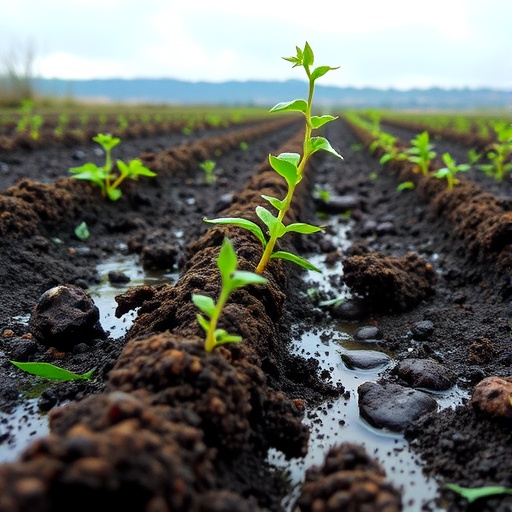The study of rare earth elements (REEs) has recently gained significant traction, especially due to their increasing relevance in modern technologies and the environmental implications of their extraction and usage. A groundbreaking investigation, led by researchers Fabijańczyk, Zawadzki, and Łukasik, dives into the concentrations of these elements in topsoil across industrially impacted regions of Poland. Their research provides critical insights into the extent of REE contamination and its implications for local ecosystems and human health.
The case study concentrates on two primary areas: the Jizera Mountains and the Upper Silesian Industrial Area (USIR). These regions have a rich industrial history, characterized by mining and manufacturing activities that have, over the years, likely contributed to environmental degradation. As a result, the topsoil in these areas may contain hazardous concentrations of rare earth elements, which can pose severe risks to both biodiversity and public health.
Researchers meticulously collected soil samples from various sites within these regions to analyze the concentration levels of REEs. The targeted elements included Lanthanum, Neodymium, and others, which are essential in the manufacturing of high-tech products, including smartphones, wind turbines, and electric vehicles. These elements, while beneficial for technological advancement, become environmental hazards when present in excessive amounts in soil and water.
The methodology employed by the researchers was thorough. Samples were taken at different depths and locations to construct a detailed picture of the contamination status across the regions. This stratified sampling approach ensured that the researchers could capture variability due to factors such as industrial processes and natural soil composition. After collection, the soil samples underwent rigorous testing in accredited laboratories, utilizing advanced techniques like mass spectrometry to ensure precise and accurate results.
The findings revealed alarming concentrations of rare earth elements in many of the samples, especially in areas closer to industrial facilities. For instance, locations near historical mining operations exhibited REE levels significantly above the baseline concentrations typically found in unpolluted soils. These elevated levels raise pressing questions about the long-term ecological impact and potential risks to human health associated with exposure to contaminated soils.
One of the most concerning aspects of REE contamination is its potential to leach into groundwater sources. As these elements migrate through soil layers, they can enter drinking water, posing serious health risks to local populations. The researchers emphasize the need for immediate action, advocating for thorough investigations into water sources affected by soil contamination. The link between contaminated soil and water underscores the urgent need for evaluating and mitigating risks in these industrially impacted areas.
Moreover, the study draws attention to the bioaccumulation of rare earth elements in the food chain. As plants grow in contaminated soils, they can uptake these harmful elements, passing them on to herbivores and, subsequently, to humans. This bioaccumulation factor raises significant concerns for agricultural practices in these areas, as well as food safety for consumers who may unknowingly ingest contaminated produce.
Aside from health implications, the research also highlights the environmental repercussions of REE contamination. Terrestrial ecosystems are delicately balanced, and the introduction of heavy metals and rare earth elements can disrupt microbial activity, soil fertility, and overall ecosystem health. The disruption of these factors could have cascading effects, impacting not only local plant and animal life but also the economic activities reliant on these ecosystems, such as agriculture and tourism.
The authors call for an integrated approach to managing these industrial sites. They suggest that remediation efforts should be based on rigorous scientific evidence, prioritizing both environmental restoration and public health safeguards. Monitoring programs should be established to routinely assess soil and water quality in suspected industrial areas, combined with public health campaigns to inform local communities about potential risks associated with contaminated land.
This research underscores the critical need for regulatory frameworks to address the environmental impact of industrial activities, particularly in regions with a legacy of mining and heavy industry. Policymakers are urged to incorporate scientific findings into decision-making processes, ensuring that stringent guidelines for soil and water quality are established and enforced to protect human health and the environment.
In conclusion, the assessment of rare earth elements in industrially impacted topsoil presents a vital lens into the complex interplay between contaminating industries and the environment. The work by Fabijańczyk, Zawadzki, and Łukasik serves as a clarion call to action, highlighting the urgent need to address contamination issues and implement sustainable practices in areas riddled with industrial activities. As the demand for rare earth elements continues to rise globally, this research stands as a pivotal reminder that environmental stewardship must remain a priority in pursuit of technological advancement.
Understanding the balance between industrial growth and environmental integrity is paramount. By addressing these issues head-on, we can forge a path toward a sustainable future that not only prioritizes technological innovation but also safeguards the health of our planet and its inhabitants.
Subject of Research: Assessment of rare earth elements (REEs) in industrially impacted topsoil in Poland.
Article Title: Assessment of the concentration of rare earth elements (REEs) in industrially impacted topsoil: a case study from the Jizera Mountains and Upper Silesian Industrial Area (USIR), Poland.
Article References:
Fabijańczyk, P., Zawadzki, J. & Łukasik, A. Assessment of the concentration of rare earth elements (REEs) in industrially impacted topsoil: a case study from the Jizera Mountains and Upper Silesian Industrial Area (USIR), Poland.
Environ Monit Assess 197, 1121 (2025). https://doi.org/10.1007/s10661-025-14583-5
Image Credits: AI Generated
DOI:
Keywords: rare earth elements, topsoil contamination, environmental health, industrial impact, bioremediation.




